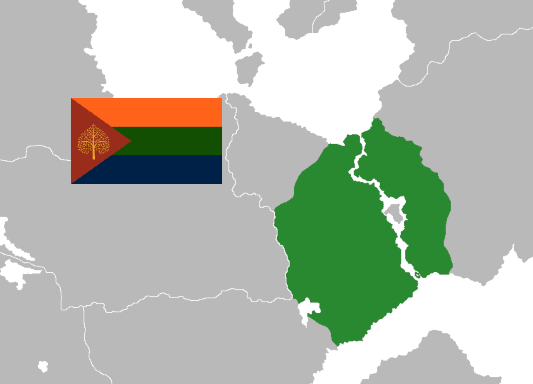
Official Name (long): Esmiran State
Common Name (short): Esmir
Motto: “Humanity, Faith, Labor”
National Anthem: Motherland We Praise
Capitol: Zey
Largest City: Alo Yopa
Demonym: Esmiran
Language: Esmiri
Population: 47 Million
Government type: Unitary Dahorianist one-party state
Leader(s): Aboa Habshi
Legislature: Civilizational Legal Center
Formation: 1974
Total GDP: 926,840,000,000
GDP per capita: 9,860
Currency: Esmiran chol
Calling Code: +95
ISO 3166 code: .es
Esmir, officially the Esmiran State, is a country in Gondwana that spans across both sides of the Esmiri Strait. Throughout history, modern-day Esmir was occupied by a range of empires with a occasional periods of unification under imperial dynasties. In 1910, the Sara Dynasty united much of modern Esmir’s borders under its control by annexing two of its vassal states. In 1933, there was a failed attempt at a seizure of power from liberal elements within the House of Sara that resulted in a large-scale conflict between loyalists and supporters of the ‘opposite faction’. While this faction was swiftly defeated within the House of Sara, the wave of political dissidence only continued to get stronger as supporters began to rally behind the new Republican Movement. In 1945, the military forced Emperor Tetbe’s abdication, leading to the Republic of Esmir. The republic suffered food shortages and political turmoil during its short-lived existence until 1947 when leftists in the military launched another coup and established the Socialist Republic of Esmir. In response to the socialist takeover, and anonymous writer published State & Civilization under the pseudonym Edho Dahorian. The book, which opposed all ideologies and instead presented a concrete psychogeographical, sociopolitical, phenomenological, and ontological analysis that was at its core existentialist while borrowing from the “ideologies” of the world, “having discarded their delusions for content”. In 1948, the Dahorianist League was established in Alo Yopa by university students. While it was at first a group composed of thinkers on the fringe of Esmiran politics, the organization capitalized off of a wave of discontentment with the socialist regime from 1953 onward, leading to its ban by the government. Still, it continued to grow in popularity and began participating in protests, charity programs, and self-sufficiency initiatives for farming communities across the country. Between 1953 and 1957, the Dahorianist League prepared its armed forces for an insurrection. Government intelligence uncovered the plot in 1957 and managed to capture then-leader Mautin Stuye, who was swiftly executed. Tbebe Serul, Stuye’s right-hand man, took his position as chairman of the Dahorianist League and immediately began the insurrection against the socialist authority. In 1965, then-president and secretary-general of the ruling Workers’ Party was placed on house arrest by the military and replaced with Ujune Aramha, minister of transport. His regime maintained socialist aesthetics but was considered a nationalist leader. His nationalist tendencies led to a split in the Workers’ Party which prompted political purges and repressions for years up until 1971, when he was pressured by his cabinet to liberalize. Aramha died in 1973 and his son, Iruyo Aramha, was placed as his successor. Unlike his father, Iruyo was deeply unpopular and was overthrown by insurrectionary forces the year after.
Upon taking power, the Dahorianist League proclaimed the Esmiran State in 1974. The former Workers’ Party was completely purged by the Dahorianists and was merged into the Dahorianist League, which was renamed the Civil Rally. Being openly anti-democracy, Serul rejected the notion of a popular election. Instead, he instituted “reconciliatory totalitarianism”. While the socialist republic depended on the largely progressive urban intelligentsia and the secularist segment of the working class, Serul appealed to the peasants and conservative elements of the working class. In 1977, Serul began to institute academic reform, which eventually coalesced into the Cosmotechnical Revolution (1977-1989). The Cosmotechnical Revolution saw the complete rejection of the “thalassocratic” philosophical tradition. Academists, scientists, politicians, and students were sent to the countryside to “realize” the masses. This has a profound effect on the sciences even today, as academics and politicians are expected in Esmir’s political culture to “get their hands dirty”. A surge in cinema, art, and poetry resulted from this stage of Cosmotechnical Revolution. The second stage involved a “reengagement” with technology: a renewed understanding of the culture’s relation to technology according to territorial interests and underlying territorial cosmology. Having spent the former half of the Cosmotechnical Revolution persecuting academia and even to some extent the use of technology, Serul used the second half to breathe new life into it. Serul died in 1988 and the Cosmotechnical Revolution ended a year later.
Since the 1990s, the Esmiran State’s unique insights regarding geopolitics have placed it in an interesting position. For the most part, it remains rigidly isolationist and militaristic while placing an emphasis on its Dahorianist anthropology, which remains the core of Esmiran political life. The country is exceedingly critical of the “seafaring empires” of the world, which it sees as individual projects of an antagonistic “thallasocratic subject”. Esmir considers itself a “land empire”, to say that its territory being the subject of Esmiri reality reinforces its closed, associative quality, while the “seafaring empires” maintain the sea as the subject of the cosmopolitan reality, which reinforces the open and dissociative quality. The supreme leader of Esmir, officially the Supreme Leader of the Civil Rally, is Aboa Habshi.